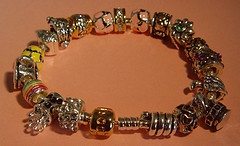
The Necklace as Jewelry Transcends Cultures and Time
A representation of feminine beauty and mystique, the necklace has been an integral part of a woman’s decoration and beauty for ages. Whether a choker, rosary or chain, the necklace has achieved a timeless appeal. In many cultures, necklaces have marked cultural distinctions, based on ornamentation, length and attire. From Greek mythology to the French Revolution, the necklace has played a major role in cultures worldwide.
Since the dawn of time, necklaces have been fashioned from jewels, chains, rocks, metal, cloth, wood, and shells. As one of the first man-made objects for wearing around the neck, necklaces once served as an elemental piece of apparel for men and women. Prehistoric fashions that draped around the neck and torso (forming the shape of a safety pin) were used to clasp layers of clothing. Among the ancient Egyptians, necklaces formed a fundamental part of dress. For example, the Ankh was worn to symbolize the amulet of life. Egyptians also adorned their necklaces with gold, beads and jewels, which later served as temptation for grave robbers centuries later.
In ancient Rome, young boys wore a bullah, or a chain around the neck with a pouch containing an amulet. While the bullah was worn by most classes, the upper class had amulets made of gold. These necklaces were intended to provide protection as boys were considered the stronger species in need of special protection. In comparison, Roman men wore signet rings of iron or gold. These rings were used to seal official documentation. Since Roman women during these times did not enjoy the same societal status as their male counterparts, jewelry was a mechanism of showcasing their particular position in society. According to one source, when a 195 B.C. law suggested that women give their jewelry away for use in war materials, women protested in the streets. Typical jewels of the day included amber, gold, pearls, polished stones, and glass beads.
During the Medieval ages, necklaces were simple and practical. But as history progressed through the 14th through 16th centuries, jewelry in general became more glamorized, especially neckwear. Intricately designed chains and collars graced the necks of ladies.
With all the power, prestige and beauty contained within one piece of jewelry, perhaps it is not so surprising that the necklace played an integral role in the downfall of France’s monarchy. Known as the “Affair of the Diamond Necklace,” the incident involved the court of Louis XVI and Queen Marie Antoinette who was implicated in a crime to swindle the crown jewelers for the cost of a very expensive diamond necklace. The scandal added to the disillusionment of France’s people with their monarchy, which along with other events, eventually culminated in the French Revolution.
In the Eastern part of the world, necklaces have long been fashioned with an array of exquisite jewelry and gold. In fact, gold necklaces play a very important role in Middle Eastern dress even today. The Arabian necklace symbolizes not only an embellishment, but also a form of security and an economic marker. Islamic calligraphy and Quranic symbols are also prevalent.
Neckwear in Assam, India, is often typified with motifs of orchids and flora and fauna. Other Indian jewelry ranges from religious to domestic. In areas surrounding temples, shops sell sanctified necklaces made of scented sandalwood, silk and gold. Worn by married Hindu women, the mangal sutra symbolizes love in holy matrimony. It is made of a combination of black beads and a gold pendant.
In Africa, necklaces designed from colorful beads have been used as part of traditional attire for centuries. African neckwear has also been used to designate tribal heritage, status, and for currency exchange.
No matter the cultural destination, the necklace has been an important decoration for ages. Some cultures have even utilized the necklaces to identify cultural and class distinctions. Indeed, the necklace has played a major role in cultures worldwide.
About the Author
Lewis Jewelers is proud to carry the full line of
Pandora Jewelry
. Pandora bracelets, Pandora charms and Pandora beads are only a part of the collection. For more information, Lewis Jewelers, 2000 West Stadium Blvd., Ann Arbor, Michigan, 48103, 877-88-LEWIS or visit the website.